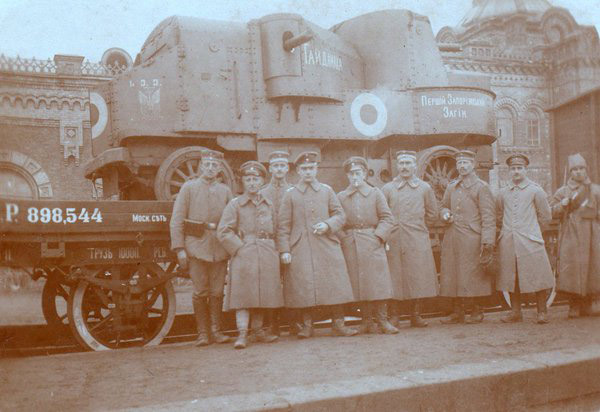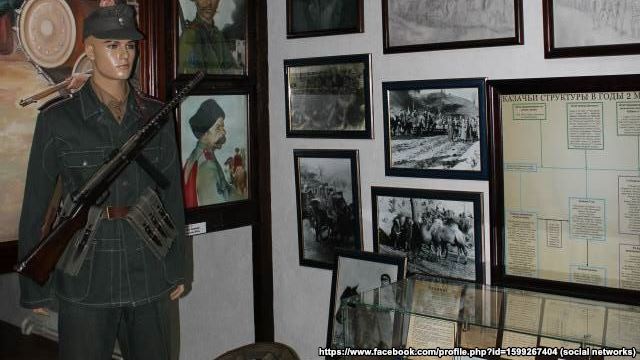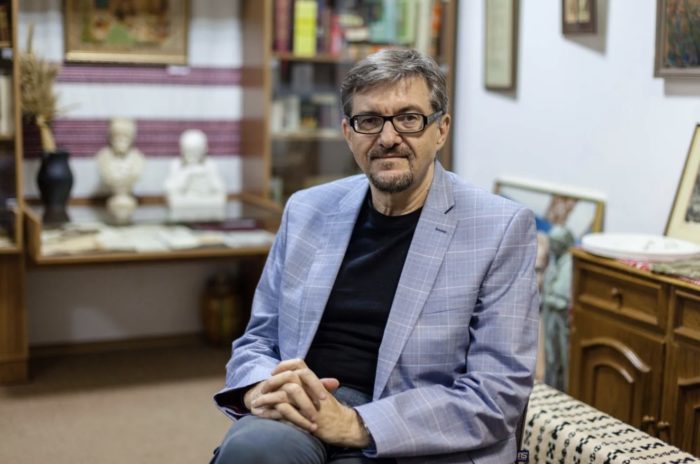“Nowhere in Ukraine have Ukrainian troops been welcomed with such enthusiasm and applause as in Simferopol and other occupied Crimean towns.”
– Memoirs of Borys Monkevych, Ukrainian sotnyk in the Crimean campaign of 1918)
– Salaam Aleikum! Don’t shoot! Glory to Ukraine!
They moved forward and stood under the only lamp in Dzankoy railway station – about twenty men, lean, dark-skinned, and black-haired.
– Glory to the heroes! replied the Ukrainian sotnyk incredulously, without lowering his shotgun.
– We want to join your ranks, said the eldest man with a strong accent – We know how to shoot. We have horses. Give us weapons and we’ll bring more men… The Russian army is bad. The Ukrainian army’s good.
The sotnyk lowered his gun and turned to the adjutant:
– Get to Bolbochan as fast as you can! Ask him what we’re supposed to do with some Crimean guys who want to fight the moskali!
50,000 RUBLES REWARD
When the adjutant reached the headquarters, the commander of the Crimean regiment of the Ukrainian National Army 34-year-old Colonel Petro Bolbochan had just finished giving his final orders. The Ukrainian cavalry was ordered to destroy the Bolshevik units at Yevpatoria. The enemy infantry divisions were to be driven back to Feodosiya and Kerch. The remaining Ukrainian troops were preparing to storm Simferopol in two days.
The news about the Crimean Tatars who wanted to join the Ukrainian army was received with enthusiasm. Bolbochan didn’t have a big cavalry division and needed more horsemen. In addition, his Zaporozhian units were a little lost in Crimea.
Bolbochan was a legendary figure. Soldiers believed he was immune to bullets and could easily defeat superior forces thanks to some kind of heavenly protection. Under his leadership, the Zaporozhian Regiment had won incredible battles.

Petro Bolbochan was born on October 5, 1883 in the village of Hyzhdevo (now Yarivka), Tchernivtsi Oblast. He was a Colonel in the Army of the Ukrainian National Republic. In the fall of 1917 Bolbochan became commander of the First Ukrainian Republican Regiment of the Second Serdiuk Division. In 1918, as commander of the First Zaporozhian Division, which was stationed in Kharkiv, he participated in the Crimean campaign. Under the Hetman government, Bolbochan was commander of the Second Zaporozhian Regiment. In the fall of 1918, the Directorate of the Ukrainian National Republic appointed him commander of the Zaporozhian Corps and of the entire UNR Army in Left-Bank Ukraine. After the army retreated to Right-Bank Ukraine, he was relieved of his command and sent to Halychyna (January 1919). Charged with insubordination for attempting to take over the command of the Zaporozhian Corps in Proskuriv in June 1919, he was found guilty by a military court and executed on June 28, 1919.
In 1918, the Bolsheviks were seriously worried about the Ukrainian national revival, and the Kremlin decided to step up its military assault on Ukraine. In response, the Central Council proclaimed the independence of the Ukrainian National Republic, and asked Germany, Austria-Hungary, the Ottoman Empire and Bulgaria for military assistance.
The Bolshevik army was not able to stand up to a well-organized 300,000 Prussian-Austrian army, which, together with Ukrainian divisions, drove the Bolsheviks to Ukraine’s borders. Petro Bolbochan commanded a Zaporozhian regiment numbering 2,600 bayonets, 80 sabres, and 10 guns. Basically, patriotic former officers of the tsarist army, students, seminarians and cadets served in the regiment.
The Germans admired the courage and fighting spirit displayed by the Ukrainian Kozak divisions. The Bolsheviks feared them and put a 500,000 ruble reward on Bolbochan’s head. Bolbochan survived several attacks – Bolshevik agents tried to shoot him in Poltava, White Guard officers in Kharkiv. Bolbochan managed to escape them all… and went on to return Crimea to Ukraine.
UKRAINE, CRIMEA AND THE TREATY OF BREST-LITOVSK
The Bolsheviks had spent three million rubles on fortifying the Crimean isthmus, having built a strong defensive line with the latest technology. Bolbochan left his railroad car and stepped into the cool spring night. As he gazed silently towards Dzankoy, he remembered his reconnaissance mission near Novooleksiyivka when his troops first observed the Russian fortifications. Through the dawn mist, they could see two long lines of dark trenches with intermittent concrete machine-gun posts. The artillery positions could be seen a little further. His scouts told him that such fortifications and long-range guns stretched along the entire isthmus. Bolbochan then remembered his conversation with the commander of the 15th German Landwehr Division, General Robert von Kosch, whom he had met in Melitopol.
“We need heavy artillery to take the Crimean fortifications. I know how brave Ukrainian soldiers are, but what can a brave man do against a 10-inch gun?

Bolbochan smiled… The UNR government had ordered him to take Crimea and the Black Sea Fleet. But, this mission was complicated as Ukraine’s allies – the Germans – did not know about this operation and were sure that Ukrainian troops would be bound by the Brest-Litovsk Treaty*, under which the Ukrainian delegation had given up the peninsula. At that time, the Germans had been surprised and tried to convince the Ukrainians to keep Crimea as it was the key to the Black Sea.
*The Treaty of Brest-Litovsk was concluded between the Ukrainian National Republic (UNR) and the Central Powers of Germany, Austria-Hungary, Türkiye, and Bulgaria on 9 February 1918 in Brest, Belarus, thus ending Russia’s participation in WW I. It provided Ukraine with German military aid in clearing Bolshevik forces from Ukraine in February–April 1918. However, the treaty was short-lived. The Treaty of Rapallo of 1922 between Germany and Soviet Russia canceled the German commitments made at Brest-Litovsk. The disintegration of Austria-Hungary automatically annulled Austria’s commitments. Türkiye renounced the Peace Treaty of Brest-Litovsk by signing a treaty with the Ukrainian SSR in 1922.

At that time, the head of the People’s Council of Ministers of the Ukrainian People’s Republic, Vsevolod Holubovych announced firmly:
“The fate of Crimea should be in the hands of the Crimean Tatars. We will uphold Ukrainian statehood on the principle of self-determination, with no annexation or indemnities.”

The Germans had no choice but to remove Crimea from Ukrainian interests. This enabled Bolshevik Russia to consider the peninsula its own territory. In March 1918, the Taurida Soviet Socialist Republic was declared.
Two and a half months later, Holubovych changed his mind and on April 10, 1918 Petro Bolbochan received a secret order from the UNR Minister of War Oleksandr Zhukyvsky to drive the Bolsheviks from Crimea.
That evening, Bolbochan managed to convince General Robert von Kosch that it was necessary to reconnoiter Russian positions in Crimea. Von Kosch had also received an order to drive the Bolsheviks from Crimea and realized that Bolbochan would never be able to do so on his own. Moreover, he was a pragmatic man and did not want to send his own soldiers to a certain death.
BREAKTHROUGH
Four thousand foot soldiers, one thousand mounted soldiers, ten armoured cars, four artillery batteries and two armoured trains… Who could imagine that such a small army would be able to capture Crimea’s impregnable fortifications?
Bolbochan smiled and glanced at two guards standing near him on the railway embankment. Their caps were decorated with an insignia depicting the Archangel Michael. The Kozak fighters, in fact, often said that they were sent by God to deliver their people from the bloody Bolsheviks. As they retreated, remembered Bolbochan, Russian troops blew up bridges, destroyed railway tracks, burned food warehouses and slaughtered anyone in their way… He had seen many atrocities in his marches from Kyiv to Kharkiv and then onto Melitopol, but for some reason the incident at Lyubotin Station stood out most clearly. One of the rooms was packed with condemned men whom the Bolsheviks had not had time to execute; near the well lay dozens of bodies bearing signs of torture; on the platform stood a wagon with still warm bodies of horses. The Bolsheviks had shot or stabbed them with their swords so that “they wouldn’t fall into enemy hands”…
When Bolbochan’s troops arrived in Novooleksiyivka, defeating Petro Lazarev’s Third Revolutionary Army and liberating Pavlohrad, Oleksandrivsk, Melitopol and Berdiansk, the “Defence Staff of the Crimean Soviet Republic” in Simferopol had no idea that this had happened. The Bolshevik commanders were convinced that the front was still very far away from the peninsula.

On the night of April 20, 1918, armoured trains and motorcars carried Bolbochan’s troops across Chonharsk Bridge, opening fire on the Bolshevik guards and attacking the rear positions of the Russian forces. The soldiers in the trenches started to panic; they threw down their weapons and fled deeper into the peninsula. The Ukrainian artillery divisions opened fire from the mainland, covering the Ukrainian motor cars and trains as they advanced across the bridge. After a short, but heavy battle, Ukrainian troops took Dzhankoi on the evening of April 22, 1918.
Capture of Simferopol
Two days later, on April 24, when Ukrainian armoured cars appeared on the streets of Simferopol, the Bolshevik troops put up little resistance and fled the city, leaving behind valuable documents, letters and maps. They did not even have time to inform their command in Sevastopol about the fall of Simferopol, so taking advantage of the situation, Bolbochan spoke with the Sevastopol garrison, posing as a representative of the Red army military command. It turned out that the Russians preferred to hand the city to the Ukrainians rather than the Germans.
Many officers of the Black Sea Fleet in Sevastopol decided to join the UNR. Hearing about Bolbochan’s conquest, Admiral Mykhailo Sablin issued an all-round order:
“All ships, port equipment and fortifications situated along the coast are now the property of the Ukrainian National Republic. Therefore, the Ukrainian flag will be raised everywhere and on all the ships.”

The order was opposed by a few ships where the Bolsheviks had gained the upper hand. About 80% of the crews were ethnic Ukrainians who wanted to join Bolbochan’s army. Long queues of men wanting to obtain Ukrainian UNR citizenship lined up outside the Ukrainian Commissariat on Nakhimovska Street in Sevastopol.
Bolbochan’s train was solemnly welcomed at the Simferopol railway station by a delegation of municipal government authorities and Tatar Kurultai (which had been dissolved and banned by the Bolshevik government). The whole city was decorated with flowers, and the streets were filled with festively dressed people.
In his memoirs, sotnyk Borys Monkevych noted he “would never forget the enthusiasm and ardour displayed by Crimean residents as they welcomed Bolbochan and the Ukrainian officers in Simferopol. Nestor Monastyriov, an officer in the Black Sea Fleet, described the event:
“The whole town is covered with Ukrainian and Tsarist flags, flowers and garlands. Everyone’s in the streets People laugh and cry, hug and cross themselves… Thank God! The Ukrainians are here!”
Bolbochan was especially pleased to welcome the First Cavalry Regiment, which had been disarmed by the Bolsheviks; these men were ready to join the ranks of the Ukrainian army. Tatar volunteers could also join the Ukrainian cavalry. With their help, the Ukrainian Army took Bakhchisaray on April 25. The road to Sevastopol was free.
Post Scriptum…
When von Kosch found out about Bolbochan’s capture of Simferopol, he immediately ordered the Ukrainian army to halt all offensive operations. Arriving in the Crimea, he ordered Bolbochan to abandon everything and return to the mainland, but Bolbochan replied that he couldn’t do this without a direct order from the Ukrainian government. Surprised, the German General contacted Kyiv and asked for an explanation. But, the UNR War Office replied that “no troops had been sent to Crimea”. On April 26, the Germans surrounded Ukrainian positions in Crimea and demanded their immediate surrender. In response, the Zaporozhian divisions stated that they were ready to fight to the end and deployed their artillery…

The situation grew more and more tense with each passing hour. Bolbochan and the commander of the Zaporozhian Corps Zurab Natishvili arrived from Kharkov and tried to call Kyiv headquarters. Finally, War Minister Oleksandr Zhukivsky responded:
“You are to accept the demands of the Germans, surrender your weapons, military equipment and leave Crimea.”
Bolbochan answered that he would never carry out such an order. After days of tough negotiations with General von Kosch, the UNR troops withdrew from Crimea armed and in full battle array.
A few days later, on April 29 1918, a coup d’etat toppled the Ukrainian National Republic and Pavlo Skoropadsky became Hetman of Ukraine. He dismissed the Central Rada and abolished all the newly promulgated laws. However, he managed to convince the Central Powers that liberated Crimea should remain Ukrainian and the Black Sea Fleet should be considered the property of the Ukrainian state.
In November 1918, Skoropadsky was removed from power in an uprising led by Symon Petliura and the withdrawal of German forces from Kyiv. The uprising nominally restored the Ukrainian National Republic, but power was vested in a Directorate, a provisional government of five directors chaired by Volodymyr Vynnychenko. The Kremlin announced the Ukrainian government in Kyiv illegitimate and without declaring war, moved its troops into Ukraine.
At the end of January 1919, Petliura, feeling that the government was hanging by a thread and fearing a military coup, decided to get rid of the powerful Bolbochan who openly criticized his policies. At the height of the war with Soviet Russia, Bolbochan, who commanded the armies of Left-Bank Ukraine, was arrested on false charges and after a quick trial sentenced to death. One of the best Ukrainian military leaders was executed on June 28, 1919 at Balyn Station, Khmelnitsky Oblast.
The men chosen to carry out the sentence refused to fire on their Colonel. Bolbochan was executed by the head of the counterintelligence unit of the UNR army, Petliura’s advisor, Mykola Chebotarev.
In 1934, veterans of the Zaporozhian Corps organized a second trial in Prague, proving Bolbochan’s innocence. The most interesting statement was pronounced by the former head of the UNR Council of Ministers Borys Martos:
“Well, you’re asking me why Bolbochan was shot. Just imagine this elegant gentleman, clean-shaven, powdered, perfumed, in lacquered boots and with a riding whip in his hand. Can this really be an officer of the Ukrainian army? No, not at all… more like a reactionary dandy! Imagine what would’ve happened if he’d ruled our country. We had to shoot him… and we did!”
Symon Petliura was shot in Paris, seven years after Petro Bolbochan’s death. His assassin was acquitted and released. The Chairman of the UNR Council of Ministers Vsevolod Holubovych died in Stalin’s camps, where he spent almost 20 years. Traces of War Minister Zhukivsky and Bolbochan’s comrade-in-arms during the Crimean campaign Natishvili were lost in the whirlpool of revolutionary events. Petliura’s security chief Chebotarev died at a ripe old age in West Germany.
In November 1920, the Bolsheviks captured the positions of the White Army in Crimea and the last ships commanded by White officer Piotr Wrangel evacuated to Türkiye. The Bolsheviks then proceeded to literally drown the peninsula in blood. Between 50,000 to 150,000 people were killed in 1920-1921. Not only were persons suspected of having links with the White movement or the Ukrainian underground immediately executed, but also their family members, priests, and even persons who had moved to Crimea during Ukrainian or White rule… More than 100,000 Crimeans perished from hunger in 1921-1923 during the famine instigated by Soviet authorities. Crimea remained under the thumb of the Soviet empire for 70 years, and during this time everything possible was done to erase the memory of Colonel Petro Bolbochan’s famous raid on Crimea that gave Crimeans almost a year of freedom in 1918.
Related:
- Princess Olha of Kyiv: a golden page in Ukrainian history
- The history behind “Bitter Harvest,” dramatic movie about the Holodomor
- History in a bottle: unique documents belonging to UPA family found in Ivano-Frankivsk Oblast
- The History of the Ukrainian National Flag (Infographics)
- Counterfeiters. How Russia is rewriting history, again
- Ihor’s life story: a mirror image of Ukraine’s history in the 20th century
- A short history of the Ukrainian greeting “Slava Ukrayini!”
- Crimean history. What you always wanted to know, but were afraid to ask





